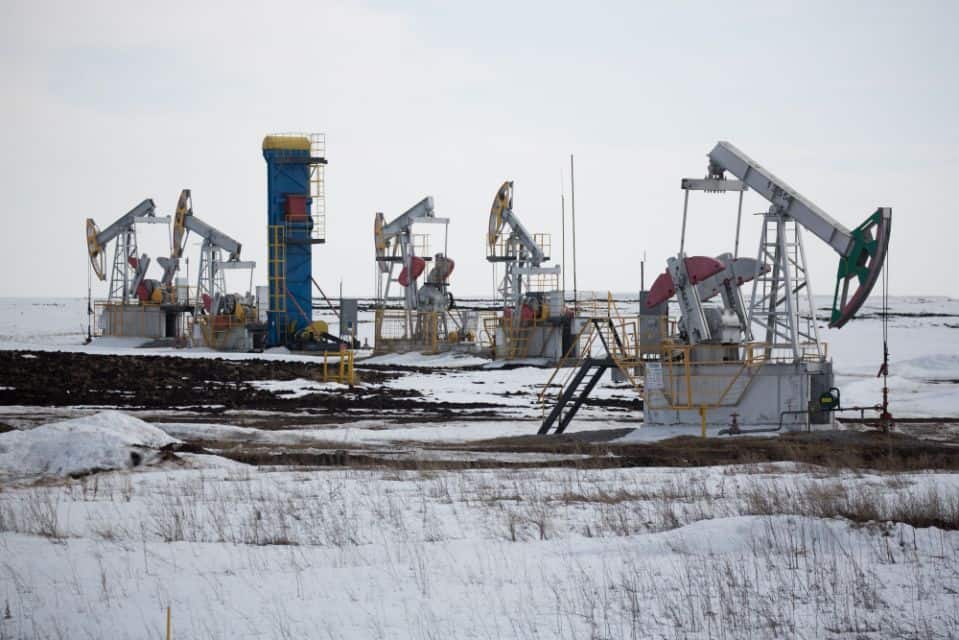OPEC+ is poised to agree a production increase this week as it seeks to cool a rapid rally in crude prices.
There’s a widespread view within the group that the market can absorb additional barrels, according to people familiar with the deliberations. While the usual differences are present — with Saudi Arabia cautious and Russia keen to open the taps — all sides are ready to increase production, they said, asking not to be named because the information was private.
That could put the group on track to implement the majority of the 1.5 million barrel-a-day output increase that’s up for debate on Thursday.
An agreement to hike OPEC+ supply would be the latest sign that the global economy is recovering from the damage wrought by the coronavirus pandemic. The cartel has endured a year of pain, dominated by the deepest output cuts in its history. But the sacrifice has paid off, reviving oil prices back to pre-crisis levels above $60 a barrel.
Brent crude rose 0.3% to $62.89 a barrel as of 7:54 a.m. in London. The international benchmark has surged more than 20% this year.
“Both the global economic outlook and oil market prospects show signs of continued improvement,” OPEC Secretary-General Mohammad Barkindo said at the opening of a meeting of the group’s technical experts on Tuesday. “The headwinds of uncertainty that shocked and disrupted the market last year continue to abate.”
There are two distinct elements to the production increase that the Organization of Petroleum Exporting Countries and it allies will debate this week.
First, will the cartel proceed with a 500,000 barrel-a-day collective output hike in April? Second, how will Saudi Arabia phase out the extra supply reduction of 1 million barrels a day it’s been making voluntarily in February and March?
Robust Demand
Russia has been the most consistent advocate for the 500,000 barrel-a-day increase, and other members now largely agree that it should go ahead, according to people familiar with the matter.
The top oil executive from the United Arab Emirates, which has also supported output hikes at recent OPEC+ meetings, gave a bullish assessment of the market on Tuesday.
“Oil demand is robust,” Sultan Al Jaber, the chief executive officer of Abu Dhabi National Oil Co., said at the IHS Markit Ltd. CERAWeek virtual conference. “Demand will rise to above pre-Covid levels by the end of this year.”
Adnoc has already signaled it’s preparing to open the taps, allocating customers greater volumes of Murban, Das and Upper Zakum crudes for April compared with March.
Saudi Choice
Saudi Arabia always said that its voluntary supply reduction would only last for two months, but seasoned OPEC-watchers have suggested that Riyadh could phase it out gradually.
The kingdom will start to roll back its extra cut as planned in April, but is still discussing internally whether to return all of the barrels in a single month, or over a longer period, said people familiar with the deliberations. The decision will take into account the commissioning of the new 400,000 barrel-a-day Jizan refinery, which could affect both domestic crude consumption and exports, they said.
At CERAWeek, Saudi Aramco CEO Amin Nasser struck a more cautious tone than his counterpart from the UAE, predicting strong demand in the second half of 2021, and a return to pre-Covid consumption next year.
Remarkable Comeback
Whatever the Saudis decide, the global oil market is poised to receive its biggest supply boost since August, when OPEC+ first began the process of tapering the 9.7 million barrel-a-day cut agreed in April last year as the pandemic crushed demand.
The group appears to think the market is ready for it. Even if OPEC+ boosts production by 2.4 million barrels a day between February and June — the maximum amount allowed under the current deal — it will still be able to clear the remnants of the 2020 supply glut by August, the secretariat’s analysts predicted on Tuesday.
Achieving that would be a remarkable comeback from one of the biggest crises in the cartel’s history. It’s almost exactly a year since a disagreement between Russia and Saudi Arabia over how to respond to the early stages of the pandemic triggered a monthlong price war. The group flooded the market just as demand plunged, a disastrous decision that pushed crude prices below zero for the first time in history.
Twelve months later, fuel stockpiles in industrialized countries aren’t far off target levels and crude prices are close to break-even for some members, presenting “the perfect opportunity for OPEC+ to raise production,” analysts at Australia & New Zealand Banking Group Ltd. said in a note.

